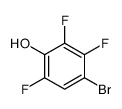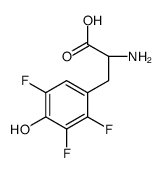2,3,6-trifluorophenol

2,3,6-trifluorophenol structure
|
Common Name | 2,3,6-trifluorophenol | ||
|---|---|---|---|---|
| CAS Number | 113798-74-6 | Molecular Weight | 148.08300 | |
| Density | 1.473g/cm3 | Boiling Point | 137ºC at 760mmHg | |
| Molecular Formula | C6H3F3O | Melting Point | 33-37 °C(lit.) | |
| MSDS | Chinese USA | Flash Point | 147 °F | |
| Symbol |


GHS02, GHS07 |
Signal Word | Danger | |
| Name | 2,3,6-trifluorophenol |
|---|---|
| Synonym | More Synonyms |
| Density | 1.473g/cm3 |
|---|---|
| Boiling Point | 137ºC at 760mmHg |
| Melting Point | 33-37 °C(lit.) |
| Molecular Formula | C6H3F3O |
| Molecular Weight | 148.08300 |
| Flash Point | 147 °F |
| Exact Mass | 148.01400 |
| PSA | 20.23000 |
| LogP | 1.80950 |
| Vapour Pressure | 5.81mmHg at 25°C |
| Index of Refraction | 1.471 |
Synonym:None Section 2 - COMPOSITION, INFORMATION ON INGREDIENTS
Risk Phrases: 36/37/38 Section 3 - HAZARDS IDENTIFICATION EMERGENCY OVERVIEW
Irritating to eyes, respiratory system and skin. Potential Health Effects Eye: Causes eye irritation. May cause chemical conjunctivitis. Skin: Causes skin irritation. Ingestion: May cause gastrointestinal irritation with nausea, vomiting and diarrhea. The toxicological properties of this substance have not been fully investigated. Inhalation: Causes respiratory tract irritation. May cause allergic respiratory reaction. May cause nausea, dizziness, and headache. Can produce delayed pulmonary edema. Chronic: Effects may be delayed. Section 4 - FIRST AID MEASURES Eyes: Immediately flush eyes with plenty of water for at least 15 minutes, occasionally lifting the upper and lower eyelids. Get medical aid. Skin: Get medical aid. Flush skin with plenty of water for at least 15 minutes while removing contaminated clothing and shoes. Wash clothing before reuse. Ingestion: Get medical aid. Do NOT induce vomiting. If conscious and alert, rinse mouth and drink 2-4 cupfuls of milk or water. Wash mouth out with water. Inhalation: Remove from exposure and move to fresh air immediately. If not breathing, give artificial respiration. If breathing is difficult, give oxygen. Get medical aid. Notes to Physician: Treat symptomatically and supportively. Section 5 - FIRE FIGHTING MEASURES General Information: As in any fire, wear a self-contained breathing apparatus in pressure-demand, MSHA/NIOSH (approved or equivalent), and full protective gear. During a fire, irritating and highly toxic gases may be generated by thermal decomposition or combustion. Extinguishing Media: Use agent most appropriate to extinguish fire. Use water spray, dry chemical, carbon dioxide, or appropriate foam. Section 6 - ACCIDENTAL RELEASE MEASURES General Information: Use proper personal protective equipment as indicated in Section 8. Spills/Leaks: Vacuum or sweep up material and place into a suitable disposal container. Clean up spills immediately, observing precautions in the Protective Equipment section. Avoid generating dusty conditions. Provide ventilation. Section 7 - HANDLING and STORAGE Handling: Minimize dust generation and accumulation. Avoid contact with eyes, skin, and clothing. Keep container tightly closed. Avoid ingestion and inhalation. Use with adequate ventilation. Wash clothing before reuse. Storage: Store in a tightly closed container. Store in a cool, dry, well-ventilated area away from incompatible substances. Section 8 - EXPOSURE CONTROLS, PERSONAL PROTECTION Engineering Controls: Facilities storing or utilizing this material should be equipped with an eyewash facility and a safety shower. Use adequate ventilation to keep airborne concentrations low. Exposure Limits CAS# 113798-74-6: Personal Protective Equipment Eyes: Wear appropriate protective eyeglasses or chemical safety goggles as described by OSHA's eye and face protection regulations in 29 CFR 1910.133 or European Standard EN166. Skin: Wear appropriate protective gloves to prevent skin exposure. Clothing: Wear appropriate protective clothing to prevent skin exposure. Respirators: A respiratory protection program that meets OSHA's 29 CFR 1910.134 and ANSI Z88.2 requirements or European Standard EN 149 must be followed whenever workplace conditions warrant respirator use. Section 9 - PHYSICAL AND CHEMICAL PROPERTIES Physical State: Solid Color: off-white Odor: Not available. pH: Not available. Vapor Pressure: Not available. Viscosity: Not available. Boiling Point: Not available. Freezing/Melting Point: 33 - 37 deg C Autoignition Temperature: Not available. Flash Point: 63 deg C ( 145.40 deg F) Explosion Limits, lower: Not available. Explosion Limits, upper: Not available. Decomposition Temperature: Solubility in water: Specific Gravity/Density: Molecular Formula: C6H3F3O Molecular Weight: 148.09 Section 10 - STABILITY AND REACTIVITY Chemical Stability: Stable at room temperature in closed containers under normal storage and handling conditions. Conditions to Avoid: Incompatible materials, dust generation, excess heat. Incompatibilities with Other Materials: Strong oxidizing agents. Hazardous Decomposition Products: Carbon monoxide, irritating and toxic fumes and gases, carbon dioxide, hydrogen fluoride gas. Hazardous Polymerization: Will not occur. Section 11 - TOXICOLOGICAL INFORMATION RTECS#: CAS# 113798-74-6 unlisted. LD50/LC50: Not available. Carcinogenicity: 2,3,6-Trifluorophenol - Not listed by ACGIH, IARC, or NTP. Section 12 - ECOLOGICAL INFORMATION Section 13 - DISPOSAL CONSIDERATIONS Dispose of in a manner consistent with federal, state, and local regulations. Section 14 - TRANSPORT INFORMATION IATA Not regulated as a hazardous material. IMO Not regulated as a hazardous material. RID/ADR Not regulated as a hazardous material. Section 15 - REGULATORY INFORMATION European/International Regulations European Labeling in Accordance with EC Directives Hazard Symbols: XI Risk Phrases: R 36/37/38 Irritating to eyes, respiratory system and skin. Safety Phrases: S 26 In case of contact with eyes, rinse immediately with plenty of water and seek medical advice. S 37/39 Wear suitable gloves and eye/face protection. WGK (Water Danger/Protection) CAS# 113798-74-6: No information available. Canada None of the chemicals in this product are listed on the DSL/NDSL list. CAS# 113798-74-6 is not listed on Canada's Ingredient Disclosure List. US FEDERAL TSCA CAS# 113798-74-6 is not listed on the TSCA inventory. It is for research and development use only. SECTION 16 - ADDITIONAL INFORMATION N/A |
| Symbol |


GHS02, GHS07 |
|---|---|
| Signal Word | Danger |
| Hazard Statements | H228-H302-H312-H315-H319-H332-H335 |
| Precautionary Statements | P210-P261-P280-P305 + P351 + P338 |
| Personal Protective Equipment | dust mask type N95 (US);Eyeshields;Gloves |
| Hazard Codes | Xn,Xi:Irritant; |
| Risk Phrases | R20/21/22 |
| Safety Phrases | S26-S36/37/39 |
| RIDADR | UN 1325 4.1/PG 2 |
| WGK Germany | 3 |
| Packaging Group | III |
| Hazard Class | 4.1 |
| HS Code | 2908199090 |
|
~% 
2,3,6-trifluoro... CAS#:113798-74-6 |
| Literature: US5849959 A1, ; |
|
~% 
2,3,6-trifluoro... CAS#:113798-74-6 |
| Literature: Journal of the Chemical Society, Perkin Transactions 2: Physical Organic Chemistry (1972-1999), , p. 691 - 696 |
| HS Code | 2908199090 |
|---|---|
| Summary | HS: 2908199090. derivatives of polyphenols or phenol-alcohols containing only halogen substituents and their salts. VAT:17.0%. tax rebate rate:9.0%. supervision conditions:None. MFN tariff:5.5%. general tariff:30.0% |
|
19F NMR metabolomics for the elucidation of microbial degradation pathways of fluorophenols.
J. Ind. Microbiol. Biotechnol. 26(1-2) , 22-34, (2001) Of all NMR-observable isotopes 19F is the one most convenient for studies on the biodegradation of environmental pollutants and especially for fast initial metabolic screening of newly isolated organi... |
|
|
The site-selective functionalization of halogen-bearing phenols: an exercise in diversity-oriented organometallic synthesis. Marzi E and Schlosser M.
Tetrahedron 61(13) , 3393-3401, (2005)
|
| 2,3,6-Trifluorophenol |
| 2,3,4-TRI-O-BENZYL-Β-D-GLUCOPYRANOSIDURONIC ACID BENZYL ESTER,TRICHLOROACETIMIDATE |
| Phenol,2,3,6-trifluoro-(9CI) |
| 2,3,6-trifluoro-phenol |
| MFCD00061214 |


 CAS#:192446-70-1
CAS#:192446-70-1 CAS#:182756-60-1
CAS#:182756-60-1 CAS#:116751-24-7
CAS#:116751-24-7
